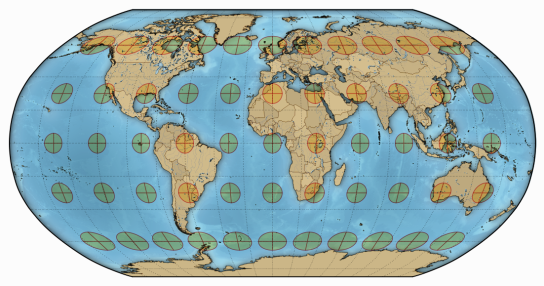Creating a Tissot’s Indicatrix in QGIS
The task of projecting, or unfolding the spherical Earth onto a flat map, is an age old problem in cartography. Projection almost always introduces distortion, most projections cannot preserve angles, areas and distances at the same time, they may be conformal (angle-preserving), equal-area (area-preserving) or equidistant (distance preserving) but not all at once. The only exception is a Globe, which preserves angles, areas and distances perfectly. Thus a projection is a compromise.
The choice of projection depends on a map’s use, scale and audience. Conformal projections, for example, are preferred for nautical charts or small scale maps because they locally preserve angles necessary for navigation and survey drawings. Equal-area projections are best suited for maps of broad continental region as they preserve the relative sizes of countries, seas and oceans and allow comparison between regions. Finally, there are hybrid projections that minimise the distortion by merging conformal and equal-area projections, these can be used to create visually pleasing maps of the entire Earth (for a guide to selecting a map projection see Fig. 9 in Jenny (2011), link below).
But how does one measure the degree and type of distortion in a map projection?
One elegant method was developed in the 1880s century by the French cartographer Monsieur Nicolas Auguste Tissot, the Tissot’s Indicatrix (or Tissot’s Ellipse). This mathematical contrivance consists of a grid of infinitely small circles that measures the degree and type of distortion caused by projection. While Monsieur Tissot’s approach is mathematical, involving infinity small circles, his technique can be approximated overlaying a regular grid of large circles and crosses to a map.
The Indicatrix Mapper plugin for QGIS by Ervin Wirth and Peter Kun creates a Tissot’s Indicatrix by adding a vector layer of circles and crosses in a gridded pattern on a map. The degree and type of distortion of the Tissot’s Indicatrix reveals the class of map projection as follows: –
- If a projection is conformal, the area of circles and sizes of the crosses will change while the shapes of circles remain the same and intersection angle of the crosses will always meet at 90 degrees e.g. Mercator projection
- If a projection is equal-area, the area of the circles will remain the same while the shape of the circles change and intersection angle of the crosses will not always meet at 90 degrees e.g. Mollweide projection or Hammer projection
- If a projection preserves neither property, the area of the circles and their shape will change, and the intersection angle of the crosses will not always meet at 90 degrees e.g. Robinson
After adding the Indicatrix Mapper plugin to QGIS (menu Plugins – Manage and Install Plugins) first add a basemap using the OpenLayers plugin e.g. Bing Aerial layer, then click the Indicatrix Mapper icon and run the plugin using default settings. You can then select different projections (lower right in world icon QGIS) to see the effects of various protections on the Tissot Indicatrix. If the circles appear as squares after selecting a different projection, right click the Circles layer in the layers panel, then select the Rendering tab and deselect the Simplify geometry check box. Also, turn off the basemap layer when using different projections, unfortunately the OpenLayers plugin only supports Google Mercator projection (EPSG 3857). To create the basemap below, that can be displayed using different projections, I styled vector data downloaded from Natural Earth and OpenStreetMap.

Mercator Projection – the area of the circles and size of the crosses increase towards the poles but their shape remains the same.

Mollweide Projection – the area of the circles remain the same but their shapes are distorted, the crosses do not always intersect at 90 degrees.

Robinson Projection – both the area of the circles and intersection angle of the crosses circles vary.
It is important to note that a Tissot’s Indicatrix generated in QGIS is an approximation of mathematical ideal, we are not no longer dealing with infinity small circles. As a result, here will be some minor distortion visible towards the edge of a map independent of the projection used; notice that the circles in the Mercator projection nearest the poles are not quite symmetrical or the circles at the edge of the Mollweide projection do not appear to preserve area as they should. This anomalous distortion can be minimised by reducing the size and spacing of the circles and crosses created by the Indicatrix Mapper plugin. However, despite these limitations a Tissot’s Indicatrix elegantly reveals the distortion present. This is something to important to understand when when choosing a map projection.
References:







